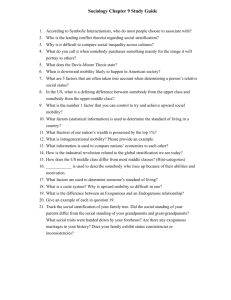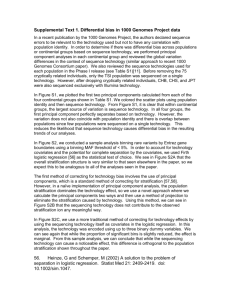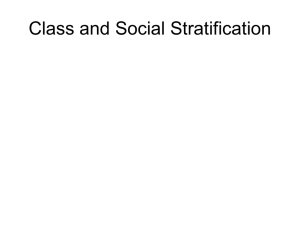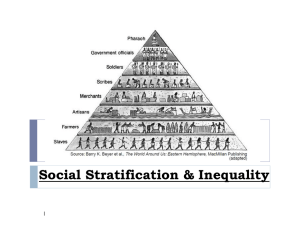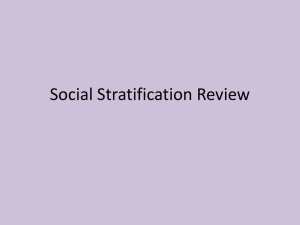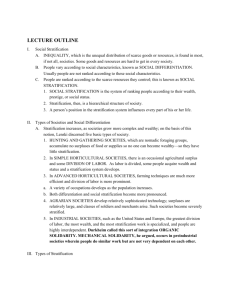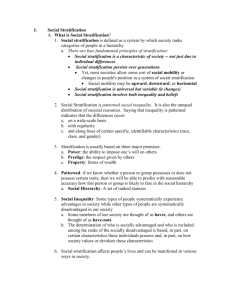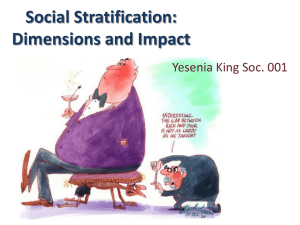social stratification and social mobility in the caribbean
advertisement
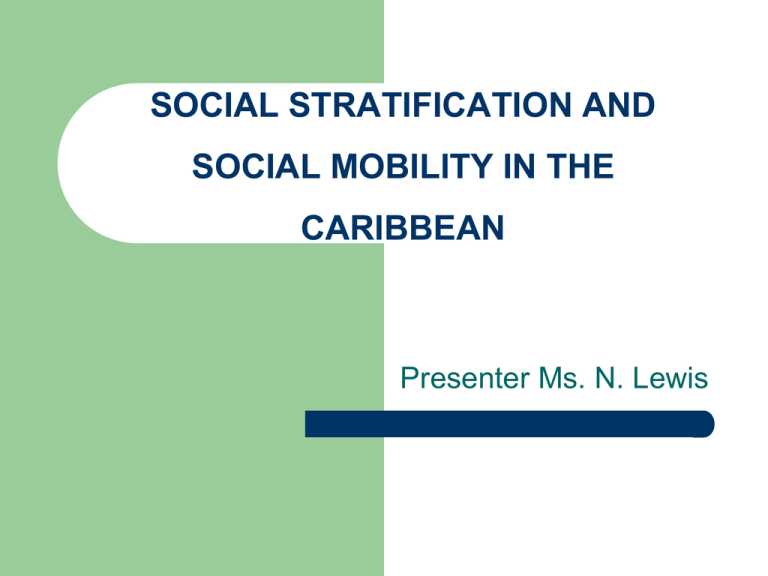
SOCIAL STRATIFICATION AND SOCIAL MOBILITY IN THE CARIBBEAN Presenter Ms. N. Lewis What is social Stratification? This refers to the ranking of social groups according to one or more criteria deemed important to society. The ranking indicates that some groups have more and others have less of what society values- for example, money, power and prestige. Types of stratification Systems There are two types of stratification systems: 1. Closed system of stratification 2. Open system of stratification Closed System of stratification A closed system is a rigid system with clearly demarcated boundaries Social statuses are strictly defined and determine access to opportunities Social position is ascribed at birth There is no social mobility from level to the another. An example of a closed system of stratification is the caste system in India. People are born into a caste and this determines one’s occupation, social interaction, power and education. No amount of achievement can change a persons caste. Open System of social Stratification An open form of social stratification is based primarily on economic criteria, particular income. Social position is achieved through one’s efforts The boundaries between classes are more flexible than with the closed system. There is opportunity for social mobility, as individuals can move up or down the class system and therefore their status can improve or decline. The class system in modern industrial society is the best example of an open stratification system. Social stratification Under Slavery Cont’d Whites were never apart of the lower class; only white indentured servants stained their class boundaries. Persons of mixed ancestry and lighter colour skin were the most fortunate by virtue of their appearance. Some were rewarded with lighter domestic duties. The coloured group acted as a buffer zone upholding white values and thus did not want Social Stratification Under Slavery The Plantation System was a closed system of stratification based on the ascribed criteria of race and colour. Race and colour was tied to one’s occupation in society. Social Stratification in the Caribbean The social structure of the caribbean has been greatly influenced by colonialism and slavery. Ascriptive factors such as race, class and colour determined the status and life chances of Caribbean people. Race Stratification- M.G. Smith Smith argued that most societies in the caribbean are plural where there exist significant diversity and race antagonism. Smith argued that the different ethnic or cultural groups in the Caribbean practiced distinctive forms of the same institutions in society. For example, in Trinidad the Hindus have a distinctive marriage practice of “bamboo wedding.” Neither whites nor blacks perform these social institutions along the similar lines. For Smith societies such as Trinidad, Guyana and Jamaica has a closed system of stratification that ensured limited social mobility. Criticisms of Smith The main criticisms of Smith are summarized below: 1. Caribbean societies have evolved into class societies and not cultural blocks as Smith’s model suggests. 2. Many critics argue that education has been the main equalizer in society 3. The rise of the local intelligentsia comprises of member from both African and Indian. 4. The extent and degree of conflict that Smith articulated based on culture and diversity is exaggerated. In fact, in many of the Social Stratification in Trinidad and Tobago- Lloyd Braithwaite He observed that the social structure in Trinidad was founded on ascriptive- particularistic basis. It was thus based on the positive evaluation of the white groups in society and negative evaluation of the black group. The other groups- Chinese, Indians who enter society sought to separate themselves from the blacks as much as possible. Hence ethnic identification and ethnic purity The ascriptive value system was manifested in schools, churches, carnival and sporting clubs. Unlike Smith, Braithwaite believed that society though racially stratified was a united whole, with the values and norms of the whites being adopted by the masses and regarded as mainstream. The assimilation of the Anglo-saxon value system allowed for the functional prerequisites SOCIAL MOBILITY This describes the process whereby social groups or individuals move either up or down the social strata. Wealth, status and prestige came with occupying the higher rungs of the social ladder, but one had to have what it took to earn wealth, status and prestige. Being white or light skinned was enough to gain entry into the highest ranking groups. SOCIAL MOBILITY cont’d Apart from colour, wealth and prestige social mobility could be achieved by marrying someone with money, acquiring enough educational credentials to securing a well paying job; By owning a successful business and investing wisely; By inheritance; Social mobility cont’d It can be attained intergenerationally- that is a family may move t a higher socioeconomic bracket became of hardwork, diligence and foresight of older generation. Social Mobility Cont’d The wealthier and powerful groups continue to be found exclusively in the higher social classes. While the structure of Caribbean societies today shows that many descendants of African and Indians are in higher social classes, it also shows that a large number of these groups have not been successful in accessing social mobility.
